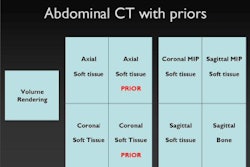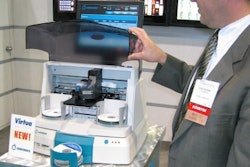To be "penny-wise but pound-foolish" is to be cautious (wise) with small amounts of money (the penny) but wasteful (foolish) with larger amounts (the pound), a philosophy embraced by far too many in today's PACS marketplace.
So what makes a person penny-wise and pound-foolish in PACS? People usually make these kinds of mistakes by looking at the minutiae instead of the big picture.
More than 85% of all PACS decisions are based on price and relationship, but price is -- or should be -- an incredibly small part of the decision-making equation. Unfortunately, price is often looked at as the deal maker or deal breaker instead of doing a more thorough look at the total cost of ownership.
An area many people often overlook is warranty terms. Warranties can be worth as much as 20% of the total quoted price. Most service agreements run 14% to 16% of system list price, but when you add discounting this inflates the net service agreement cost to close to 20%. With warranties running the gamut from no warranty at all to one year, this can save as much as $200,000 on a $1 million sale.
The warranty start date is also crucial. Most contracts state the warranty begins when the software ships or, at the very latest, upon installation. If the vendor is doing the implementation, you can typically add one to three months warranty by stating the warranty will start upon clinical acceptance.
Of course, you need to define what constitutes clinical acceptance and have those terms agreed upon by the vendor, but basically this just says the system will operate as you intended it to. This can be challenging to negotiate, though, as it may impact the vendor's ability to recognize revenue from the sale. That said, on the plus side it ensures a timely implementation as well.
When a deal isn't
Sometimes you can be fooled into thinking a deal is a better deal than it really is. Plate life in computed radiography systems (CR) is but one example.
Most CR vendors rate their plate life by the number of exposures, ranging from 10,000 to over 100,000. Most vendors will also give you a one-year warranty and some two, but read the fine print closely. You really won't burn out the plate, as most plates can handle more than 200,000 exposures, but damage to the plate and the cassette is much more likely. In the vast majority of cases, damage to the plate and cassettes also isn't covered by warranty.
The way the plate is read also impacts plate life. Physical stresses, such as bending and exposure to body fluids, can significantly degrade the plate life. With plate/cassette combinations averaging $1,000 each, it's critical to ensure that these issues are addressed in your contract.
Making sure you get the right plate combinations is also crucial. Most vendors have standard plate combinations that they bundle based on general x-ray volume, but this needs to be tailored to the type of procedures you do, not just volume alone.
If you handle a high volume of chest films, then go with more 14 x 17-inch plates; for more orthopedic, get more 8 x 10-inch ones. You can always shoot an extremity on a 14 x 17-inch plate if needed, so always go with the larger size.
Also keep in mind that while CR readers can read 100 plates per hour or more, most facilities share a single reader between two rooms and can do at most four exams per hour. Even at three exposures per exam this means the CR reader will process 24 plates per hour. This dictates needing a dozen 14 x 17-inch plates or so per machine, allowing for extras and erasure time.
Add four to six 8 x 10-inch plates and you have the full complement you need. Intermediate sizes are certainly nice to have but generally can be considered an unnecessary expense unless there is a specific reason for them.
Installation services
Installation and implementation services are a requirement from all vendors, yet the charges for these tend to boggle the mind. This is another area that you can probably negotiate.
Facilities that buy hardware and software separately pay two implementation fees -- one from each vendor -- as well as fees from vendors with whom you will be interfacing, such as RIS vendors. Unfortunately, there is usually a ton of overlap here.
Paying more than $10,000 to "rack and stack" hardware is very hard to justify when you are paying the software provider, who is doing the primary implementation, more than $60,000 for their part as well. You really need to look closely at and define the role that everyone is taking -- internally, the role of the PACS administrator, the IT department (including network support), and others, including the software vendor, the hardware provider, etc.
Vendors will try to justify their quoted expense with project planning and other items, but unless you plan on turning the entire implementation completely over to the vendor, much of what is quoted may become an unnecessary expense. Truth be known, if you calculate the implementation cost, it usually comes out as a fixed percentage of the deal price. The price quoted typically has little, if anything, to do with the actual implementation cost, but is a guesstimate based on volume that rarely correlates to the actual work that needs to be done.
Instead a 100,000-volume deal is quoted as costing $X to implement; a 250,000-volume deal costs $Y. Ask for a project plan that defines who is doing what and time frames for each, and you'll be amazed at the answers -- if you get them, that is.
Look the plan over closely, adding to it when needed and deleting areas that are unnecessary or have excess time allotted to them. If everyone's role is clearly defined and a projected time line both developed and adhered to, you should easily be able to cut implementation costs by half if not more, saving $20,000 to $50,000 in the process.
Before we go further, understand I am not saying you can do the implementation without the PACS vendor's assistance -- that would be suicidal -- but rather that you need to balance what can reasonable be done internally with what the vendor has quoted as saying it will do. Of course this also an area where you will get the most pushback from the vendor since this is one of their primary profit centers.
Most vendors will quote you a fixed price for implementation and hours. About half that is probably what is required, with the balance a cushion for overage, etc. In fairness to the vendors, some sites require every bit of time quoted if not more, but I would venture to say in a properly planned implementation you can negotiate a deal that includes much less cost than that provided by the templated prices.
I have written about service agreements time and again but I repeat my basic premise: people purchase service agreements for PAC systems not out of need but because of habit.
A PACS is not like a CT, MRI, nuclear medicine, or US device in which only a trained technician can work on it and parts are available only from the vendor. A PACS is nothing more (or less) than a conglomeration of PCs and software.
They may act as servers, workstations, interface devices, etc., but they are basically personal computers with very expensive applications software on them. Now before I incur the wrath of God, I'm not saying that support is unnecessary from the vendor -- a software-only service contract that includes remote troubleshooting via VPN or a secure dial-up line is almost a universal requirement.
Paying 8%, 10%, or even 12% of the full system list price (hardware and software) additional, though, to support system hardware is borderline insanity. On a $1 million system, this adds $80,000 to $100,000, or about $7,500 per month, for hardware support.
By comparison, most hardware vendors will provide you with three years' worth of onsite support coverage with comparable onsite response time direct for less than what the PACS vendor typically wants for a single year's coverage. Of course, this requires the PACS vendor to allow you to buy the hardware directly, something most of the major vendors will allow only at the workstation level, if that, largely so they can maintain control at the server level and maintain their uptime guarantees. That brings us to the next point.
Uptime guarantees
It's fascinating that a vendor will offer a 99% or even 99.5% uptime guarantees without a service agreement but anything higher requires one. Each 1% uptime equals seven hours and 15 minutes (7:15) of allowable downtime per month on a 24/7 measurement period.
Unfortunately, most vendors measure downtime on a cumulative basis annually or, with a very select few vendors, on a semiannually or even quarterly basis. This means you can have up to 87 hours (over 3.5 days) of downtime over the course of the year or even all at once and still be considered "up."
When you factor in all the exclusions stated in the service agreement for things such as routine maintenance, you basically get a nonguarantee guarantee. Bringing this point home even more, if you do get a 99% uptime in writing from the vendor (which virtually all will provide you with), that means you are paying over $1000 per hour for service on a service contract before the vendor is in default of their uptime guarantee.
This is equal to about three times the vendor's standard time and materials rate. Of course, being in default of a service agreement uptime guarantee really means little since very few vendors will agree to a penalty for failing to meet their uptime guarantee, and those who do tend to couch it with so many caveats and limitations that the "guarantee" is minimally useful if at all.
Contrary to what every vendor promotes and every facility looks for, uptime guarantees mean virtually nothing; response time is what is key. Realistically, if a vendor is diligently working to solve a problem, no facility that I know of is going to run a stopwatch on the vendor. No one also wants a relationship that is based on threats, yet expectations need to be set forth and guidelines established if the implementation is to be a success.
Vendors will counter that a service agreement provides priority service, a way to budget fees, etc. With the reliability of hardware these days, a high-priced service agreement on hardware just isn't required, especially if the system is properly designed with redundancy and test servers, and hardware maintenance (such as reviewing audit logs, disk defragging, and operating system updates) is performed by the PACS administrator on a routine basis.
One justification for the service agreement cost may be if the vendor includes upgrades (new hardware features) in addition to updates (bug fixes) with the costs, although less than half the vendors do this. Still, this needs to be considered, especially with lower-priced systems in which the service agreement on the complete system might actually be less than that charged for the upgrades alone.
Unnecessary technology
The last area we'll address in wasting money is use of technology to solve problems in which solutions may already exist but not be implemented. Voice recognition is one area that comes to mind here.
There is no question that being able to dictate "Dr. Jones, normal chest 2, approve" can reduce both transcription costs and report turnaround time dramatically. This is especially true in most community hospitals where better than 50% of all reports are normal.
That said, in the vast majority of cases the ability to use "canned normals" has already been paid for in the RIS implementation; it just hasn't been implemented. The process is basically the same with both technologies, but instead of dictating, the radiologist swipes a bar code relating to the normal case he or she is dictating, swipes "approve," and is done.
This provides the same process, same time-savings, same result with a net cost to the facility of zero. Of course voice recognition supporters will talk about time-savings in reporting with nonstandard reporting as well, but the bottleneck really isn't the dictation-to-transcription segment but from completed transcription to report approval.
Unless a radiologist dictates every report, reviews it on the spot, and approves it at the same time, the impact on turnaround time is minimal. Furthermore, with voice recognition you are taking radiologists who can dictate reports worth $2,000 per hour or more and bringing them to the level of a $25.00 per hour transcriptionist by having them review and edit their own reports.
Some facilities will also keep the transcriptionists in the loop to act as report editors. This provides an added cost and solves no problems; if anything this adds to the delays. Most transcriptionists can transcribe a dictated report faster than they can review a report that is on screen and edit it after the fact, so what is the true savings here?
Facilities are penny-wise and pound-foolish in so many other ways that it can and may be the source of a follow-up article. By evaluating the various solutions available to solving a problem and implementing the most cost-effective ones, facilities can allow PACS to meet its full potential while saving both time and money in the process.
By Michael J. Cannavo
AuntMinnie.com contributing writer
October 16, 2006
Michael J. Cannavo is a leading PACS consultant and has authored nearly 350 articles on PACS technology in the past 15 years. He can be reached via e-mail at [email protected].
The comments and observations expressed herein do not necessarily reflect the opinions of AuntMinnie.com, nor should they be construed as an endorsement or admonishment of any particular vendor, analyst, industry consultant, or consulting group. Rather, they should be taken as the personal observations of a guy who has, by his own account, been in this industry way too long.
Related Reading
Part XII: Exploring PACS Secrets -- PACS and marriage, August 15, 2006
Part XI: Exploring PACS Secrets -- Stop the insanity, May 29, 2006
Part X: Exploring PACS Secrets -- Excuses, excuses, May 19, 2006
Part IX: Exploring PACS Secrets -- How to fix DICOM, April 20, 2006
Part VIII: Exploring PACS Secrets: It's broke -- Fix it, April 6, 2006
Copyright © 2006 AuntMinnie.com



















